ISSN 2410-5708 / e-ISSN 2313-7215
Year 13 | No. 36 | February - May 2024
© Copyright (2024). National Autonomous University of Nicaragua, Managua.
This document is under a Creative Commons
Attribution-NonCommercial-NoDerivs 4.0 International licence.
Sustainable tourism from the social responsibility of tourism companies
https://doi.org/10.5377/rtu.v13i36.17633
Submitted on May 08th, 2023 / Accepted on December 14th, 2023
María Argentina Sevilla Ubeda
Graduate in Tourism and Hotel Administration, National
Autonomous University of Nicaragua Multidisciplinary
Regional Faculty of Chontales.
Yarineth Alexey Hurtado Cerna
Graduate in Tourism and Hotel Administration, National
Autonomous University of Nicaragua Multidisciplinary
Regional Faculty of Chontales.
Miurett Jasnary Hurtado
Graduate in Tourism and Hotel Administration, National
Autonomous University of Nicaragua Multidisciplinary
Regional Faculty of Chontales.
Jenny del Socorro Villanueva
Doctor in Economic Sciences, Professor of the Department of
Economic and Administrative Sciences, Faculty
Multidisciplinary Regional of Chontales, UNAN-Managua.
Concepción Mendoza Castro
Master in Business and Institutional Administration,
Professor of the Department of Economics and Administrative
Sciences, Regional Multidisciplinary Faculty of Chontales, UNAN-Managua.
Section: Social sciences, Business education, and Law
Scientific research article
Keywords: Tourism, Sustainability, Environmental Axis, Sociocultural Axis, Economic Axis.
Abstract
The objective of this research work is to determine sustainable tourism from the social responsibility of tourism companies, through studies carried out by Latin American countries such as Peru, Colombia, and Nicaragua, to determine how companies have been responsible for each of the axes of sustainability. This research was carried out following the guidelines of each of the proposed objectives, beginning by defining the theoretical aspect of sustainable tourism and the social responsibility of tourism companies, followed by describing social responsibility about the axes of sustainability such as the environment, socio-cultural and economic axis, and finally demonstrating how tourism companies have been responsible about the sustainability axes during a given period. The methodology is documentary since it is a data collection method in the context of mainly scientific studies, which was carried out using hermeneutic tools (signature and focalization) as an instrument of analysis and interpretation. Among the main results, it was obtained that the companies taken into account have been responsible with the axes of sustainability, some with more inclination in the environmental aspect about the conservation of the environment, and others in the sociocultural aspect, from collaborations in social projects to the respect and well-being of the workers, others with the economic axis linked to the contributions and the relationships that are created with the clients, thus achieving sustainability in their services and products offered to tourists.
INTRODUCTION
It is recognized that tourism is an ambivalent activity since it contributes through great socio-economic and cultural advantages, but at the same time contributes to the degradation of the environment and the loss of the identity of a given locality, as a result of which sustainable tourism emerges.
Through sustainable tourism, social equality, care for nature, and the profitability of public and private investments must be reconciled, balanced, and promoted, in such a way that it meets the needs of all those people who are linked to the activities of the tourism sector.
Therefore, Montivero (2014) mentions that sustainable tourism has three key components, sometimes referred to as “the triple goal” and also called by Gómez et al. (2014) as axes of sustainability, which are:
Environmentally, the activity has a low impact on natural resources, particularly in protected areas. This activity minimizes damage to the environment and ideally aims to benefit the environment.
Socially and culturally, the activity does not adversely affect the social or cultural structure of the community in which it is performed. On the contrary, it respects local culture and traditions.
Economically, the activity contributes to the economic well-being of the community, generating a sustainable and equitable income for local communities and the greatest number of actors. It benefits business owners, employees, and neighbors.
To comply with these axes, it is important to take into account companies, since, at the core of these, there are a large number of people who work for the same objective, which is why companies are encouraged to adopt social responsibility (CSR) in each of the activities they carry out and in this way comply with the three axes already mentioned above and of which we will talk in detail in the development of this document.
According to Cajiga (2009a), CSR is a business vision that integrates respect for people, ethical values, the community, and the environment with the management of the company itself, regardless of the products or services it offers, the sector to which it belongs, its size or nationality.
MATERIAL AND METHODS
This research is of a documentary analytical nature since the instrument of hermeneutics was used to collect the necessary information and thus identify whether Latin American companies are responsible for the axes of sustainability.
The information was obtained from research carried out in the countries selected for this study, which were: Peru, Colombia, and Nicaragua with a total of 22 companies.
Add a paragraph that describes in general terms the process you went through to determine your results and conclusions.
The period taken to carry out this research on sustainable tourism from the social responsibility of tourism companies was from 2015 to 2020, a period in which the study, analysis, and interpretation of data was facilitated.
RESULTS AND DISCUSSION
Initially, the comparison between the 3 countries is made to identify the socially responsible companies with each of the axes of sustainability, taking into account that sustainable tourism according to the World Tourism Organization in the magazine OSTELEA (2021) is one that fully takes into account the current and future, economic, social and environmental repercussions to meet the needs of visitors, industry, the environment and host communities.
Table 1
Number of Companies with Sustainable Tourism
|
COUNTRY |
ENTERPRISE |
FREQUENCY |
% |
|
Peru |
Restaurants & Recreation Center |
13 |
59.09 |
|
Colombia |
Hotels |
8 |
36.36 |
|
Nicaragua |
Hotel |
1 |
4.55 |
|
Total |
- |
22 |
100 |
Note. Data obtained from Tovar (2015), Peña (2018), Talavera and Úbeda (2018).
To carry out the study, 22 companies located in different countries were taken up, 13 in the minor population center of Muruhuay in Peru, 12 restaurants and 1 recreational center that represents 59.09%; 8 hotel companies in Santa Marta in Colombia with 36.36%, and finally in Nicaragua 1 hotel company with 4.55%. In this way, they demonstrate how they have been responsible for the axes of sustainability such as the economic, socio-cultural, and environmental spheres.
Table 2
Environmental axis
|
COUNTRY |
ENTERPRISE |
FREQUENCY |
|||
|
YES |
% |
NO |
% |
||
|
The City of Persia |
13 |
12 |
54.54 |
1 |
4.55 |
|
Santa Marta –Colombia |
8 |
8 |
100 |
- |
- |
|
Estelí- Nicaragua |
1 |
1 |
100 |
- |
- |
|
Total |
22 |
21 |
95.45 |
1 |
4.55 |
Note. Data obtained from Tovar (2015), Peña (2018), Talavera and Úbeda (2018).
About the environmental axis, of the 22 companies taken into account for this study, 21 are environmentally responsible, among them, 12 from Peru 54.54% and 1 4.55% that represents that it is not responsible, 8 in Colombia with l00% representing that all companies in this country are responsible with this environmental axis, as well as Nicaragua with 100% and in total it is shown that responsible companies are equivalent to 95.45% and those that are not 4.55%.
Table 3
Proper Use of Natural Resources
|
COUNTRY |
ENTERPRISE |
FREQUENCY |
|
The City of Persia |
12 |
54.54% |
|
Santa Marta –Colombia |
8 |
36.36% |
|
Estelí- Nicaragua |
1 |
4.55% |
|
Total |
21 |
95.45% |
Note. Data obtained from Tovar (2015), Peña (2018), Talavera and Úbeda (2018).
The 21 environmentally responsible companies are environmentally responsible through the proper use of Natural Resources, 12 in Peru at 54.54%, 8 in Colombia equal to 36.36%, and 1 in Nicaragua at 4.55%, being equivalent to 95.45% of the study sample.
Figure 1
Types of Natural Resources
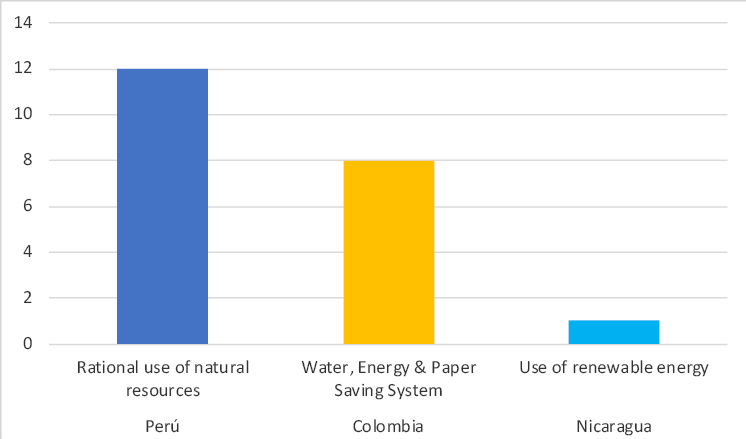
Note. The figure shows the types of use and appropriate use that companies make.
Fuente: Tovar (2015), Peña (2018), Talavera and Úbeda (2018).
Regarding the 21 companies that are environmentally responsible, equivalent to 95.45% we have that 12 companies located in Peru are environmentally responsible 54.54% through the proper use of natural resources, then, of the 8 hotel companies located in Colombia, all have systems or programs to save on the consumption of water, energy and paper with 36.36%. Finally, the Nicaraguan hotel company is 4.55% environmentally responsible through the use of renewable energy.
Table 4
Waste Treatment
|
COUNTRY |
ENTERPRISE |
FREQUENCY |
|
The City of Persia |
12 |
54.54% |
|
Santa Marta –Colombia |
8 |
36.36% |
|
Estelí- Nicaragua |
1 |
4.55% |
|
Total |
21 |
95.45% |
Note. Data obtained from Tovar (2015), Peña (2018), Talavera and Úbeda (2018).
About the environmental axis, 21 companies carry out waste treatment which represents 95.45%, which there are 12 in Peru with 54.54%, 8 in Colombia with 36.36%, and in Nicaragua 1 company that represents 4.55% of the sample taken into account for this research.
Figure 2
Types of Waste Treatment
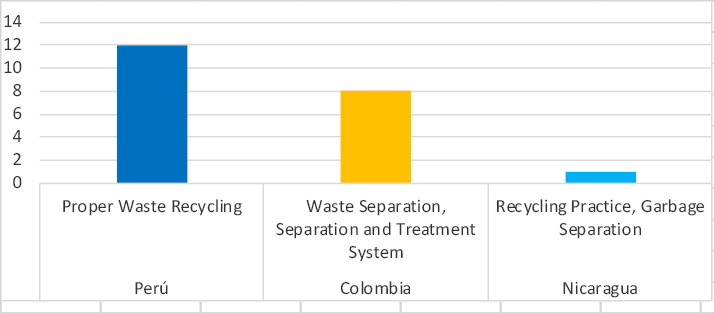
Note. The figure shows the types of treatments applied by companies in different countries.
Fuente: Tovar (2015), Peña (2018), Talavera and Úbeda (2018).
Of the 21 companies equal to 95.45% are environmentally responsible, 12 of them located in Peru carry out activities of adequate waste recycling with 54.54%, in Colombia 8 equal to 36.36% of companies have a waste reduction, separation and treatment systems, 4.55% corresponding to the Nicaraguan company these carry out recycling and garbage separation practices.
Table 5
Environmental Protection
|
COUNTRY |
ENTERPRISE |
FREQUENCY |
|
The City of Persia |
12 |
54.54% |
|
Santa Marta –Colombia |
8 |
36.36% |
|
Estelí- Nicaragua |
1 |
4.55% |
|
Total |
21 |
95.45% |
Note. Data obtained from Tovar (2015), Peña (2018), Talavera and Úbeda (2018).
In the environmental field, 21 companies are committed to the protection of the environment, equal to 95.45%, all companies located 12 in Peru which is 54.54%, 8 in Colombia with 36.36%, and 1 in Nicaragua with 4.55%.
Figure 3
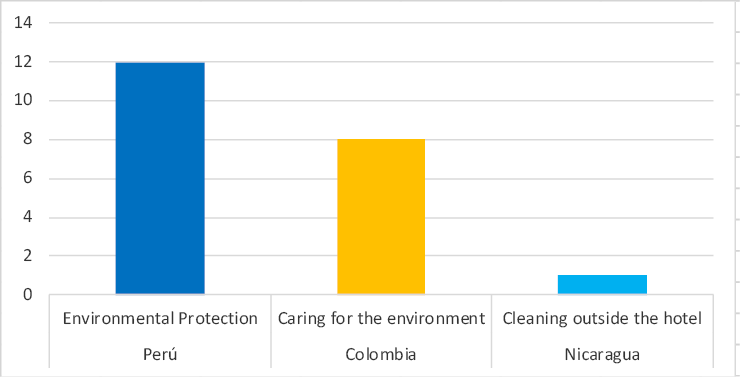
Environmental Conservation
Note. The figure shows the various forms of environmental protection.
Fuente Tovar (2015), Peña (2018), Talavera and Úbeda (2018).
Regarding the conservation of the environment, 12 companies in Peru equivalent to 54.54% carry out practices that guarantee the protection of the environment, then, of the 8 companies surveyed in Colombia that represent 36.36% these implement responsible activities that ensure the care of the environment, finally, the company located in Nicaragua carries out environmental practices such as, cleaning outside the hotel with 4.55% ensuring the conservation and preservation of the environment, all of these adding up to 21 companies that represent 95.45% of the sample under study.
Table 6
Socio-cultural axis
|
COUNTRY |
ENTERPRISES |
FREQUENCY |
|||
|
YES |
% |
NO |
% |
||
|
Peru |
13 |
6 |
27.27 |
7 |
31.82 |
|
Colombia |
8 |
8 |
100 |
- |
- |
|
Nicaragua |
1 |
1 |
100 |
- |
- |
|
Total |
22 |
15 |
68.18 |
7 |
31.82 |
Note. Data obtained from Tovar (2015), Peña (2018), Talavera and Úbeda (2018).
According to the 22 tourism companies reflected in the table, it is shown that 6 of the 13 companies in Peru equivalent to 27.27% are socially responsible, and the other 7 with 31.82% are not responsible, in Colombia, 8 are 100% responsible with this axis, finally, the one located in Nicaragua is 100% responsible, As a result, of the 22 companies taken into account for this study, only 15 of them, equivalent to 68.18%, are socially responsible.
Table 7
Collaboration in Social Projects
|
COUNTRY |
ENTERPRISE |
FREQUENCY |
|||
|
YES |
% |
NO |
% |
||
|
The City of Persia |
6 |
5 |
22.72 |
1 |
4.55 |
|
Santa Marta –Colombia |
8 |
8 |
36.36 |
- |
- |
|
Estelí- Nicaragua |
1 |
1 |
4.55 |
- |
- |
|
Total |
15 |
14 |
63.63 |
1 |
4.55 |
Note. Data obtained from Tovar (2015), Peña (2018), Talavera and Úbeda (2018).
Regarding the 6 companies located in Peru that are socially responsible, only 5 of them equivalent to 22.72% collaborate in social projects, and 1 with 4.55% does not collaborate, in Colombia the 8 companies with 36.36% if they carry out this activity, the company corresponding to Nicaragua does collaborate contributing 4.55%, therefore, only 14 companies with 63.63% are socially responsible through collaborations in social projects.
Figure 4
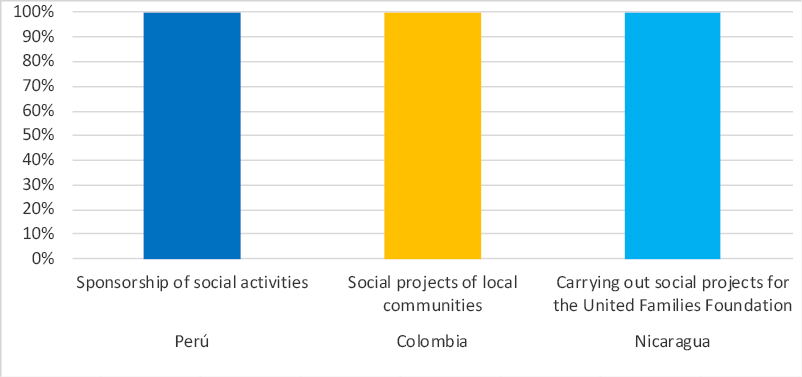
Types of Social Projects
Note. The figure shows the different projects carried out.
Fuente Tovar (2015), Peña (2018), Talavera and Úbeda (2018).
Of the 14 companies that implement collaborations in social projects equivalent to 63.63%, 5 companies in Peru do so through sponsorships in social activities that representing 22.72%, followed by the 8 companies in Colombia collaborate in social projects in local communities equivalent to 36.36%, and the Nicaraguan company with 4.55% does so through donations to the Familias Unidas Foundation.
Table 8
Respect for Human Rights
|
COUNTRY |
ENTERPRISE |
FREQUENCY |
|||
|
YES |
% |
NO |
% |
||
|
The City of Persia |
6 |
4 |
15.15 |
2 |
7.57 |
|
Santa Marta –Colombia |
8 |
8 |
36.36 |
- |
|
|
Estelí- Nicaragua |
1 |
1 |
4.55 |
- |
|
|
Total |
15 |
13 |
56.06 |
2 |
7.57 |
Note. Data obtained from Tovar (2015), Peña (2018), Talavera and Úbeda (2018).
Concerning the 6 companies located in Peru that are socially responsible, only 4 of them equivalent to 15.15% have respect for human rights, and 2 with 7.57% do not practice it, in Colombia the 8 companies with 36.36% if they carry out this activity, the company corresponding to Nicaragua if respects human rights with 4.55%, Therefore, of the 15 companies, only 13 (56.06%) are socially responsible through respect for human rights.
Figure 5
Respect for human rights.
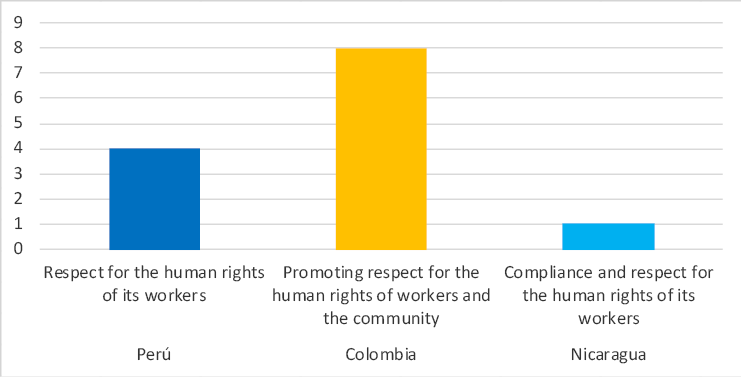
Note. The figure shows the various forms of respect for workers and the community.
Fuente: Tovar (2015), Peña (2018), Talavera and Úbeda (2018).
Regarding respect for human rights, 4 companies in Peru respect the human rights of their workers, which represents 15.15%, and the 8 companies in Colombia develop it by promoting respect for the human rights of workers and the local community, which is equivalent to 36.36%. Concerning the Nicaraguan company, it ensures compliance with and respect for the human rights of its workers equivalent to 4.55%, therefore, 13 companies with 56.06% have respect for the human rights of their workers.
Table 9
Worker Welfare
|
COUNTRY |
ENTERPRISE |
FREQUENCY |
|
The City of Persia |
6 |
27.27% |
|
Santa Marta –Colombia |
8 |
36.36% |
|
Estelí- Nicaragua |
1 |
4.55% |
|
Total |
15 |
68.18% |
Note. Data obtained from Tovar (2015), Peña (2018), Talavera and Úbeda (2018).
About the socio-cultural axis, 15 companies ensure the well-being of their workers equal to 68.18%, the companies are located 6 in Peru which is 27.27%, 8 in Colombia at 36.36%, and 1 in Nicaragua at 4.55%.
Figure 6
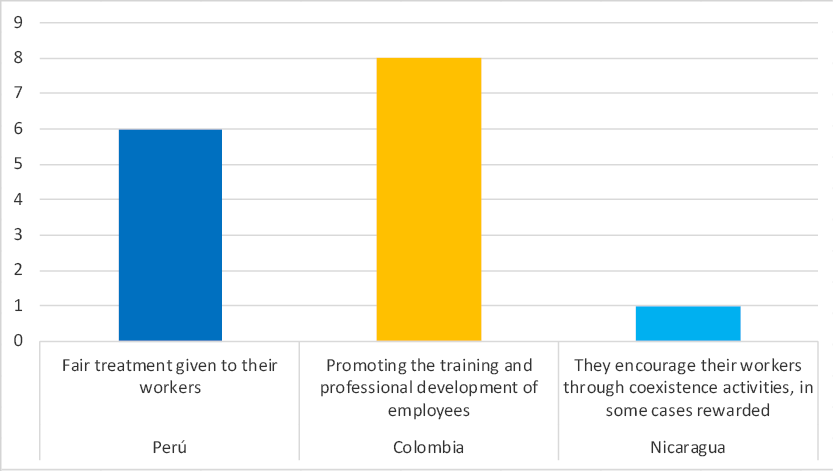
Type of Wellness
Note. The figure shows the different types of employee well-being Tovar (2015), Peña (2018), Talavera and Úbeda (2018).
Of the 15 companies corresponding to 68.18% ensure the well-being of their workers, in Peru 6 of their companies agree with the fair treatment given to their workers with 27.27%. Likewise, in Colombia, they exercise it by promoting the training and professional development of employees with 36.36%. In the same way, the Nicaraguan company encourages its workers through coexistence activities, in some cases with prizes that represent 4.55%.
Table 10
Economic axis
|
PARENTS |
ENTERPRISES |
% of responsible companies |
|
The Return of Perú |
13 |
100 |
|
Santa Marta - Colombia |
8 |
100 |
|
Estelí - Nicaragua |
1 |
100 |
|
Total |
22 |
100 |
Note. Data obtained from Tovar (2015), Peña (2018), Talavera and Úbeda (2018).
There are 22 companies responsible for the economic axis of sustainability, which is equivalent to 100%, in Muruhuay - Peru 13 companies are responsible equivalent to 100%, in Santa Marta - Colombia the 8 companies equivalent to 100% are responsible with this axis and in Nicaragua that is 1 company is responsible for 100%, Therefore, this table shows that the 22 companies considered for this study are economically responsible.
Table 11
Economic Contributions
|
COUNTRY |
ENTERPRISES |
FREQUENCY |
|
The Return of Perú |
13 |
59.09% |
|
Santa Marta - Colombia |
8 |
36.36% |
|
Estelí - Nicaragua |
1 |
4.55% |
|
Total |
22 |
100% |
Note. Data obtained from Tovar (2015), Peña (2018), Talavera and Úbeda (2018).
The 22 responsible companies with the economic axis of sustainability contribute to the economy represent 100%, in Muruhuay – Peru the 13 companies make economic contributions equal to 59.09%, followed by the 8 companies from Santa Marta – Colombia equivalent to 36.36%, and the Nicaraguan company with 4.55% make economic contributions.
Figure 7
Types of Financial Contributions
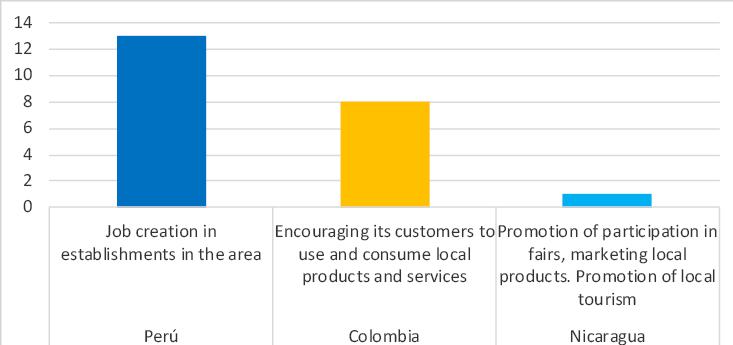
Note. The figure shows the various economic activities that are carried out. Fuente Tovar (2015), Peña (2018), Talavera and Úbeda (2018).
Of the 22 companies that were taken into account for this research, they make use of the different types of economic contributions that represent 100%, in Peru the 13 companies equivalent to 59.09% contribute to the economy through the creation of jobs in the establishments of the area, in Colombia the 8 companies equal to 36.36% contribute to the economy, encouraging its customers for the use and consumption of local products and services and in Nicaragua the company with 4.55% contributes to the economy through promotion in the participation of fairs, marketing local products, promoting rural tourism and in the promotion of handicrafts within the company’s facilities.
Table 12
Customer Relations
|
COUNTRY |
ENTERPRISE |
FREQUENCY |
|
The City of Persia |
13 |
59.09% |
|
Santa Marta –Colombia |
8 |
36.36% |
|
Estelí- Nicaragua |
1 |
4.55% |
|
Total |
22 |
100% |
Note. Data obtained from Tovar (2015), Peña (2018), Talavera and Úbeda (2018).
The 22 companies present in this study, which represent 100%, create relationships with their customers, such as the 13 companies from Muruhuay – Peru with 59.09%, the 8 companies from Santa Marta – Colombia equal to 36.36%, and the company from Nicaragua equivalent to 4.55%.
Figure 8
Type of customer relationship
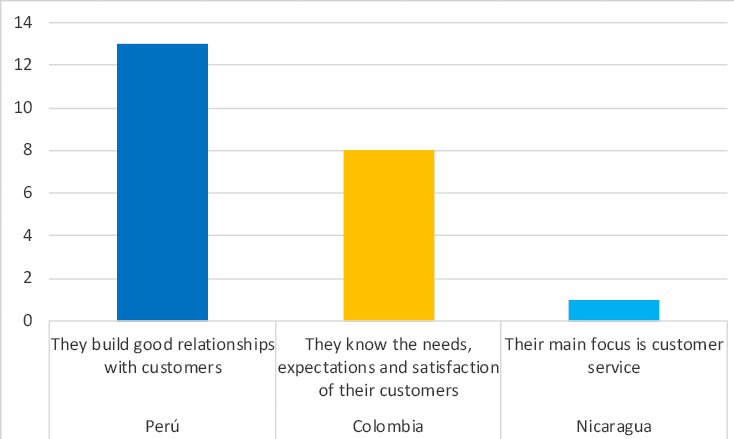
Note. The figure shows the various ways to build relationships with customers. Fuente Tovar (2015), Peña (2018), Talavera and Úbeda (2018).
Regarding the relationship that must exist between customer and service provider, 22 companies comply with it 100%, in Peru 13 companies equal to 59.09% of companies build good relationships with customers, in Colombia 8 companies at the same rate 36.36% know the needs, expectations and satisfaction of their customers and in Nicaragua the company equivalent to 4.55% has customer service as its main focus.
CONCLUSIONS
Sustainable tourism and social responsibility are very important elements for the existence of companies that are dedicated to tourism activity, the world is changing, and human beings no longer only seek development for themselves but also the care of the common home for future generations, who will inherit everything that we have managed to build. And it all starts with sustainable tourism from the social responsibility of companies.
In the environmental axis, companies have proven to be responsible in various ways, with 95.45%, through an adequate use of natural resources, establishing practices that generate the preservation of these, also through the adequate treatment of waste, to reduce the pollution that the products and services negatively offered cause. conserving the natural resources that the company possesses to obtain sustainability and therefore guarantee the protection of the environment.
Regarding the Socio-Cultural axis, companies have been responsible for 68.18%, through the realization of various social activities such as generating well-being for their workers taking into account their needs, making contributions to social projects that help the growth of local communities, reducing poverty and therefore improve the quality of life of both their workers and society.On the other hand, respect the human rights of each of the people who provide their workforce for the further development of the company.
Subsequently, in the economic axis, the responsibility that companies from different countries have is 100% through the relationships they have with their customers as well as in the economic contributions they make, thus guaranteeing economic development internally and externally, and thus creating a positive perception of these companies to their workers and to the society in general to which they belong. Thus contributing to the economy of their countries and local communities.
In conclusion, it should be borne in mind that, if a company complies with only one or two axes of sustainability, it is not considered responsible, to be socially responsible, all companies must comply with the 3 axes.
Work cited
Montivero, R. (2014). Importance of Tourism Planning for Sustainable Tourism Development. http://educacion.sanjuan.edu.ar/mesj/LinkClick.aspx?fileticket=fQe289k1jEA%3D&tabid
=677&mid=1740
Gómez Jirón, E. J., Álvarez Montiel, Q. M., & Andino Thomas, Y. L. (2014). Proposal for sustainable tourism development for the Ángel García Vázquez cooperative and Campuzano ecological camp, rancheria community, municipality of Chinandega [Bachelor’s thesis, National Autonomous University of Nicaragua]. UN. https://repositorio.unan.edu.ni/6626/1/55915.pdf institutional repository
Cajiga Calderón, J. F. (2009). The concept of corporate social responsibility. https://www.cemefi.org/esr/images/stories/pdf/esr/concepto_esr.pdf
OSTELEA. (2021). What is Sustainable Tourism? OSTELEA Turism Management School. https://www.ostelea.com/actualidad/blog-turismo/sostenibilidad/que-es-el-turismo-sostenible-segun-la-omt
Tovar Inga, D. M. (2015). Evaluation of the level of corporate social responsibility of tourism SMEs in the restaurant sector in the CPM of Muruhuay-Tarma in the period 2014 [bachelor’s thesis, National University of Central Peru]. institutional repository UN. https://repositorio.uncp.edu.pe/handle/20.500.12894/2025
Peña Miranda, D. D. (2018). The practice of corporate social responsibility in the tourism sector. A case study in hotel tourism companies in the city of Santa Martha, Colombia [doctoral thesis, University of Málaga]. UN. https://dialnet.unirioja.es/servlet/tesis?codigo=176759
Talavera Torres, J. L., & Úbeda Herrera, A. M. (2018). Diagnosis of the responsibility of the tourist services company Hotel Los Arcos of the United Families Foundation in Estelí [bachelor’s degree, Universidad Nacional Autónoma de Nicaragua]. institutional repository UN. https://repositorio.unan.edu.ni/9437/